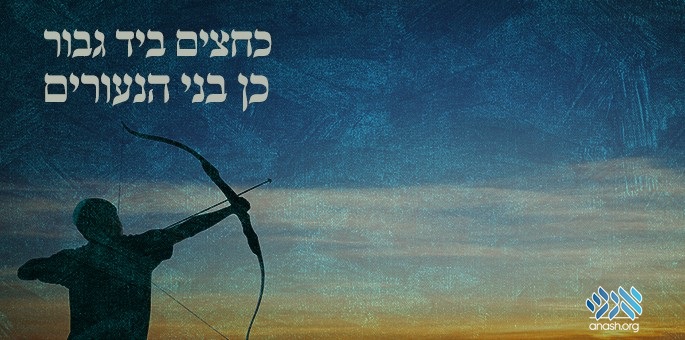י״ח אייר ה׳תשע״ט | May 23, 2019
Why the Bow and Arrow on Lag BaOmer?
There is a minhag in some communities that on Lag BaOmer, children go out into the fields and play with bows and arrows.

By Yehuda Shurpin Chabad.org
There is a minhag in some communities that on Lag BaOmer, children go out into the fields and play with bows and arrows.
A Rainbow Was Not Seen
The reason usually given for this custom is that this day marks the passing of one of the greatest sages of the Mishnah, Rabbi Shimon bar Yochai. In addition to being one of the greatest Taanaic sages, he is also known as the author of the sacred kabbalistic work the Zohar, which contains the mystical interpretations of the Torah.
The sages proclaimed that no rainbow appeared in the sky during the lifetime of RabbiShimon. What’s so great about that?
After the Great Flood in the days of Noah, a rainbow appeared in the sky—a symbol from G‑d that He would never again destroy the world by flood. The appearance of a rainbow is therefore a sign that the world, or portions of it, are deserving of punishment. Thus, the sages were proclaiming that during his lifetime, Rabbi Shimon’s merit protected the entire generation and there was no need for a rainbow to appear.
The Hebrew word for “rainbow,” keshet, refers to both the rainbow as well as the bow used in archery (in fact, the rainbow is called G‑d’s “bow”). To demonstrate that after Rabbi Shimon’s passing there is now a need for the sign of the (rain)bow, many have the custom to play with bows and arrows on this day.
The Rainbow of Moshiach
The Lubavitcher Rebbe points out that there must be a more positive reason for this custom as well, because the above reason draws attention to the fact that we unfortunately no longer have Rabbi Shimon’s merit and we therefore need the sign of the bow.
The Zohar tells us that before the coming of the Moshiach, an especially bright rainbow will appear in the sky, heralding the coming redemption. The Zohar explain that at present the rainbow appears in dull colors since it is only designed as a reminder that there shall be no return of the flood as there was in the days of Noah. At the time of the redemption, however, it will appear in its full panoply of colors as a reflection of the everlasting covenant G‑d made with His people.
Since Lag BaOmer marks the passing of Rabbi Shimon Bar Yochai, who began revealing the inner dimensions and secrets of the Torah, it is the custom to play with the bow, symbolizing the especially bright (rain)bow that will appear to herald the final redemption.
Why Especially the Students?
In addition to the passing of Rabbi Shimon, Lag BaOmer also marks the day that the students of Rabbi Akiva stopped dying. The Talmud relates that during the weeks between the holidays of Passover and Shavuot, a plague raged among the disciples of the great sage Rabbi Akiva (teacher of Rabbi Shimon bar Yochai) “because they did not act respectfully toward each other.” These weeks are therefore observed as a period of mourning. On Lag BaOmer, the deaths ceased; thus, Lag BaOmer also carries the theme of love and respect.
As the Lubavitcher Rebbe explains, this gives us a deeper understanding as to why specifically young students take time off from their studies to go out into the field to play with bows and arrows.
When it comes to learning Torah, there are two ways to go about it. If during one’s learning one recognizes and keeps in mind that it is divine wisdom, he is then ready to put aside his ego to fully understand what he is learning. And if he see someone else who perhaps understands better, not only would he not be disappointed if the person points out his error and explains the teaching to him, but on the contrary, he is happy to be corrected. After all, he now has a better understanding of G‑d’s wisdom.
If, on the other hand, it’s all about the person and his ego, and what he was able to grasp with his own intellect, then he will surely get upset if someone has a different understanding than him or tries to correct him.
The mystics explain that the sword and bow represent two ways of combating the forces of negativity. A sword is used for close combat, while the bow and arrow are used to battle from a distance. The sword represents the battle to combat the more blatant and conspicuous forms of evil, while the bow represents the combat with the more subtle and elusive negativity that appears to be distant and not a direct threat.
Furthermore, the mechanics of the bow itself teaches us a very important lesson about respect and how one can reach the greatest of heights. In order to shoot an arrow, one needs to pull the string of the bow. The further back the string is pulled, the farther the arrow can fly. The same is true with putting aside our own ego and recognizing G‑d and His wisdom. The further back we pull our own ego, the greater the heights we will ultimately reach. If we get our “selves” out of the way, we can become truly unlimited.
Thus, the custom is for specifically the young students to play with the bow, which symbolizes that through having humility, one’s learning will have the proper intentions and respect.
May we merit to see the bright rainbow heralding the coming of the Moshiach speedily in our days!

Send us your feedback